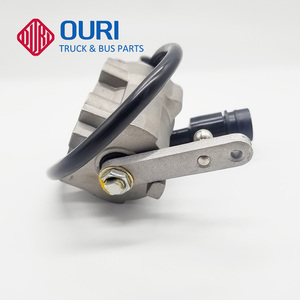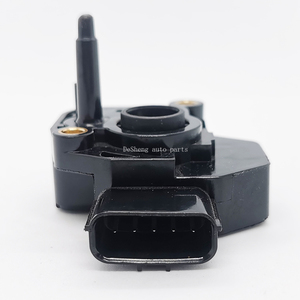(12831 products available)


















































































































































































An accelerate sensor is a device that measures the change of velocity of an object. The information gathered can be used to determine the speed and direction of movement. There are different types of acceleration sensors, namely:
The choice of an acceleration sensor depends on the specific application requirements, such as the frequency range, measurement range, size, and environmental conditions.
The specification of an accelerate sensor shows the capabilities and performance of the device.
Sensitivity
Sensitivity refers to the minimum detectable motion or change in velocity a sensor can perceive. It is usually expressed as g or m/s². A high-sensitivity value means the sensor can detect even the slightest changes in motion. Low sensitivity detects only significant changes in motion.
Measuring range
The measuring range defines the maximum and minimum acceleration levels the sensor can measure. It is expressed as g or m/s². A wide measuring range ensures the sensor can measure different applications ranging from low to high acceleration.
Cross-axis sensitivity
Cross-axis sensitivity is how much the accelerometer sensor measures motion in the wrong direction. It is expressed as a percentage of the full-scale range. Low cross-axis sensitivity means the sensor can accurately measure motion in the right direction.
Non-linearity
Non-linearity refers to how much the output of an acceleration sensor deviates from a straight line concerning the input. It is expressed as a percentage of full-scale range. Low non-linearity means the output of the sensor is accurate and consistent with the input.
Noise density
Noise density is the amount of electrical noise generated by the accelerometer sensor. It is expressed as μg/√Hz or m/s²/√Hz. Low noise density means the sensor's output is precise and stable, ensuring more accurate measurements.
Temperature range
The temperature range is the operating and storage temperature limits of the accelerometer sensor. It is expressed in degrees Celsius (°C). A wide temperature range ensures the sensor can function in different environmental conditions.
Power consumption
Power consumption is the amount of energy needed to operate the accelerometer sensor. It is expressed in milliwatts (mW). Low power consumption ensures the sensor can work for a long time in battery-powered applications.
Maintaining an acceleration sensor is essential to ensure accurate and reliable measurements of acceleration and to extend its lifespan. Here are some general maintenance tips:
Keep it clean
Regularly clean the accelerometer sensor to remove dust, dirt, and debris. Use a soft, dry cloth or brush to clean the sensor housing and surrounding areas. Avoid using wet cloths or liquids that may damage the sensor.
Avoid extreme conditions
Do not expose the acceleration sensor to extreme temperatures, humidity, or harsh environments beyond its specified limits. Such conditions can affect the sensor's performance and accuracy.
Check mounting and installation
Ensure the acceleration sensor is correctly mounted and installed according to the manufacturer's instructions. Loose or improper mounting can cause inaccurate measurements and affect the sensor's reliability.
Regular calibration
Calibrate the accelerometer sensor regularly to maintain its accuracy and reliability. Follow the manufacturer's recommended calibration schedule and use appropriate calibration tools and procedures.
Follow operating procedures
Adhere to the manufacturer's recommended operating procedures and guidelines for using the acceleration sensor. Avoid exceeding the specified measurement range or subjecting the sensor to sudden shocks or vibrations that can damage it.
Monitor performance
Regularly monitor the performance of the acceleration sensor to detect any deviations or changes in its measurements. Compare the sensor's output with expected values or reference measurements to identify any abnormalities.
Choosing the right accelerate sensor requires careful consideration of various factors to ensure it meets the intended application requirements. Here are some key factors to consider when selecting an accelerometer:
Performance:
The performance specifications of an acceleration sensor are vital; this includes sensitivity, bandwidth, and noise floor. Sensitivity indicates the smallest change in acceleration the sensor can detect. Bandwidth refers to the frequency range of the signal that can be measured, and noise floor is the minimum signal level that can be distinguished from the background noise.
Range:
Consider the range of acceleration that needs to be measured. Choosing an accelerometer with a broader range may result in less sensitivity to small changes in acceleration.
Size and package:
The size and shape of the accelerometer may be important for particular applications where space is limited. Additionally, the package style can influence the sensor's mounting and integration into the system.
Power consumption:
Power consumption is an essential consideration when selecting an accelerometer for battery-powered or energy-efficient applications. Lower power consumption results in a longer battery life and reduced energy costs.
Temperature range:
When selecting an accelerometer for use in extreme environments, it is essential to consider the operating temperature range and the sensor's ability to withstand temperature fluctuations.
Mounting and orientation:
Consider the mounting options available for the accelerometer and its orientation concerning the measured acceleration axis. Some sensors may require specific mounting techniques to ensure accurate measurements.
Cost:
The price of an acceleration sensor can vary depending on the performance, features, and application requirements. It is essential to consider the budget and find a balance between cost and the necessary performance.
It is important to note that not all vehicles have the same number of throttle position sensors. Depending on the vehicle's make and model, there could be one or more sensors. Regardless of the number, replacing an ACDelco throttle position sensor is a DIY-friendly task. But first, ensure to have the right tools for the job.
Tools needed:
Steps to replace an accelerate sensor
Q1: How do I know if my accelerometer is working?
A1: If the readings are not changing when the device is tilted, that could be a sign that the sensor is not working.
Q2: Can I fix a broken accelerometer myself?
A2: It is very hard to fix a broken accelerometer by yourself. It usually requires special tools and knowledge. It is better to have it looked at by a professional.
Q3: What is an accelerative sensor?
A3: An accelerative sensor is just another name for an accelerometer. It measures acceleration or changes in speed.
Q4: What are the two types of acceleration sensors?
A4: The two common types are microelectromechanical systems (MEMS) and piezoelectric accelerometers. MEMS is the most widely used in everyday devices.